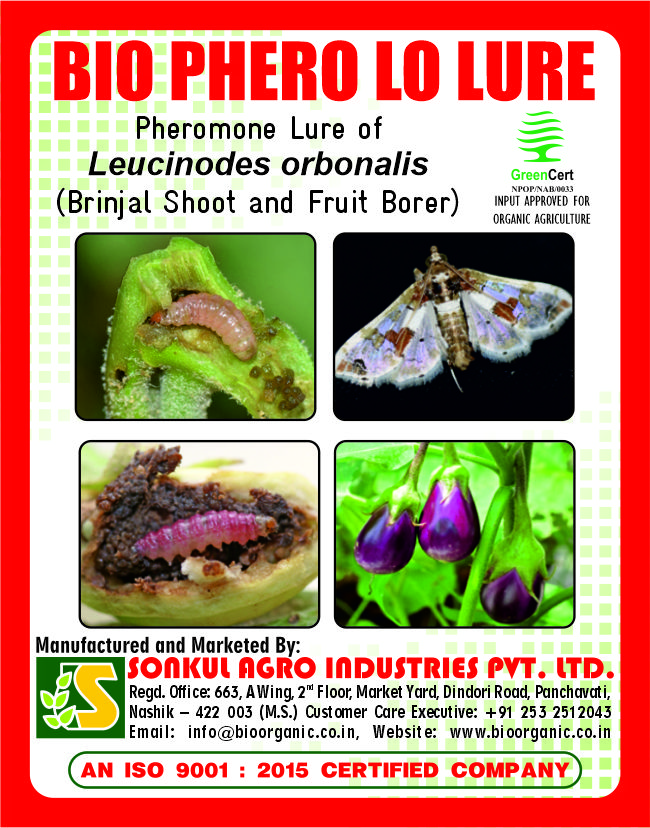BIO PHERO LO Leucinodes orbonalis (Brinjal Shoot and Fruit Borer)

Contents:
One pheromone lure of Leucinodes orbonalis
Identification-
The length of the forewings is 8.5–10.5 mm for males and 9.5–12 mm for females. The forewing ground colour is white, with a light- to dark brown basal area, delimited by a dark brown to grey antemedial line. The central dorsum has a prominent orange to dark brown L-shaped or triangular spot leading to the forewing centre and often meeting with the distal discoidal stigma. The antemedial line is sinuate, more or less distinct, but with a prominent sub costal bulge. The sub apical half of the termed has a half moon-shaped brown to grey-grown spot. The marginal line is dotted. The hind wing ground colour is white. The internal area is white, with a discoidal spot, basicostally often with an auxiliary spot. The medial line is sinuate, the distal half approaching the discoidal spot, then turning towards the dorsum. The external area is pale brown to grey with a dotted marginal line.
Life Cycle
The female lays about 250 eggs. Within 3 to 5 days larvae hatches out from the eggs. The larva enters the plant tissues immediately after their hatching and after five moultings it becomes fully matured. The fully grown larva is stout, pink coloured with brown head. The body bears wart all over the body through which hairs protrudes out. Larval period last for about 10-15 days. The matured larva comes out of the host tissues and forms pupa among the fallen leaves or on the surface of stem and fruits of the host plant. The adult moths live for two to five day. The life cycle is completed in 21-43 days. There are five overlapping generations in their active phase in a year. During winter the larvae hibernates inside the soil.
Nature of Damage
Larva is a internal feeder it immediately bore into the nearest tender shoot or flower or fruit just after hatching,. Soon after boring into shoots or fruits, they plug the entrance hole with excreta. As a result, the affected twigs flower and fruits dries up and may drop off.
Larval feeding, inside shoots, result in wilting of the young shoot. Presence of wilted shoots is the surest sign of damage by this pest. The damaged shoots ultimately wither and drop off. This reduces plant growth, which in turn, reduces fruit number and size. New shoots can arise but this delays crop maturity and the newly formed shoots are also subject to larval damage. Larval feeding in flowers results in failure to form fruit from damaged flowers. Larval feeding inside the fruit results in destruction of fruit tissue. The feeding tunnels are often clogged with frass. This makes even slightly damaged fruit unfit for marketing. The yield loss varies from season to season and from location to location.
Target Plants
Brinjal
Usage Instruction
- Cut open this pack and slide the lure piece outside. Do not touch the lure by bare hands.
- Fix this lure properly in trap by sliding it in the hole provided in the delta trap.
- Replace the lure at the recommended duration.
- Wash hand thoroughly before and after handling trap and lure.
- Discard used lure by burning or burying underground.
Trap to be used : Delta Trap
Number of traps per Acre: 15 to 20
Life of Lure : 60 Days